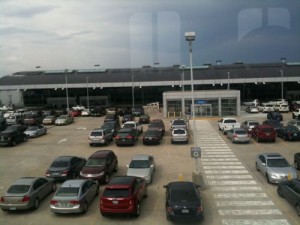Lenore K. Sullivan Born 110 Years Ago Today

If you’ve spent anytime by the Arch or riverfront you’ve likely walked, biked or driven along Lenore K. Sullivan Blvd. Have you ever stopped to ask yourself who was this woman? If so, here’s your answer:
Leonor Kretzer Sullivan (August 21, 1902 in St. Louis, Missouri – September 1, 1988 in St. Louis) was a member of the United States House of Representatives from Missouri. She was a Democrat and the first woman in Congress from Missouri.
Sullivan attended Washington University in St. Louis and was a teacher and director at St. Louis Comptometer school. She was married to John B. Sullivan, who served four terms in Congress, and she served as his administrative aide. Following her husband’s death in 1951, she served as an aide to Congressman Leonard Irving until she left to run for Congress herself in 1952. She was re-elected eleven times. In Congress, she served for many years as Secretary of the House Democratic Caucus.
Sullivan helped create the food stamp program, which was opposed by Agriculture Secretary Ezra Taft Benson and became law in the 60s during the Kennedy and Johnson administrations.
Sullivan was one of very few members of Congress, and the only woman member of Congress, to vote against the Equal Rights Amendment for women in the early 1970s.
She did not seek re-election in 1976, and was succeeded by Dick Gephardt. The former Wharf Street in front of the Gateway Arch in Downtown St. Louis was renamed Leonor K. Sullivan Boulevard in her honor. (Wikipedia)
Sullivan was 49 years old when she became a widow then she served 24 years in Congress.
Here’s a quote attributed to her:
“A woman with a woman’s viewpoint is of more value when she
forgets she’s a woman and begins to act like a man.”
Her congressional bio:
SULLIVAN, Leonor Kretzer, (wife of John Berchmans Sullivan), a Representative from Missouri; born Leonor Alice Kretzer, August 21, 1902, in St. Louis, Mo.; attended public and private schools; attended Washington University, St. Louis, Mo.; teacher and director, St. Louis Comptometer School; served as administrative aide to her husband, John B. Sullivan, 1942-1951, and as secretary to United States Representative Irving of Missouri until May 1952, when she resigned to campaign for congressional nomination; elected as a Democrat to the Eighty-third and to the eleven succeeding Congresses (January 3, 1953-January 3, 1977); chair, Committee on Merchant Marine and Fisheries (Ninety-third and Ninety-fourth Congresses); was not a candidate for reelection to the Ninety-fifth Congress in 1976; died on September 1, 1988, in St. Louis, Mo.. (US Congress)
So next time you’re on Lenore K. Sullivan Blvd. you’ll know a little bit more about her. Maybe at a St. Louis themed trivia night some information here will help you team. Oh yes, 110 years ago today was her birthday.
— Steve Patterson








